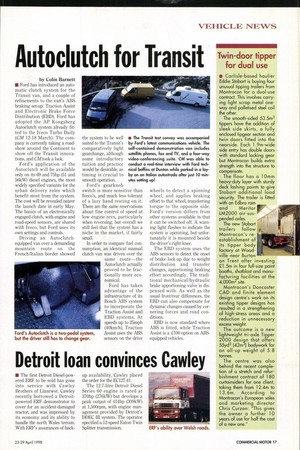Autoclutch for Transit by Colin Barnett • Ford has introduced
Page 15

If you've noticed an error in this article please click here to report it so we can fix it.
an automatic clutch system for the Transit van, and a couple of refinements to the van's ABS braking set-up: Traction Assist and Electronic Brake Force Distribution (EBD). Ford has adopted the AP Kongsberg Autoclutch system already fitted to the Iveco Turbo Daily (CM 12-18 March). The company is currently taking a roadshow around the Continent to show off the Transit innovations, and CM took a look.
Ford's application of the Autoclutch will be available only on its 69 and 75hp (51 and 56kW) diesel engines, the most widely specified variants for the urban delivery roles which benefit most from the system. The cost will be revealed nearer the launch date in early May. The basics of an electronically engaged clutch, with engine and road-speed sensors, are shared with Iveco, but Ford uses its own settings and controls.
Driving an Autoclutchequipped van over a demanding mountain route on the French/Italian border showed the system to be well suited to the Transit's comparatively light gearchange, although some introductory tuition and practice would be desirable, as timing is crucial to smooth operation.
Ford's gearknob switch is more sensitive than Iveco's, and much less tolerant of a lazy hand resting on it. There are the same reservations about fine control of speed at low engine revs, particularly when reversing, but overall we still feel that the system has a niche in the market, if fairly small.
Ford has taken advantage of the infrastructure of its Bosch ABS system to incorporate the Traction Assist and EBD systems. At speeds up to 25mph (40km/h), Traction Assist uses the ABS sensors on the drive wheels to detect a spinning wheel, and applies braking effort to that wheel, transferring torque to the opposite side. Ford's version differs from other systems available in that it can be switched off. A warning light flashes to indicate the system is operating, but unfortunately it is mounted beside the driver's right knee.
The EBD system uses the ABS sensors to detect the onset of brake lock-up due to weight distribution and transfer changes, apportioning braking effort accordingly. The traditional mechanical/hydraulic brake apportioning valve is dispensed with. As well as the usual front/rear differences, the EBD can also compensate for dynamic changes caused by cornering forces and road conditions.
EBD is now standard where ABS is fitted, while Traction Assist is a £100 option on ABS equipped vehicles.










































































































